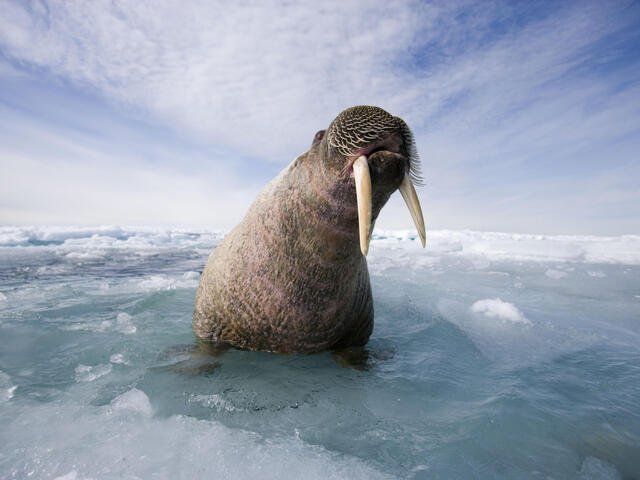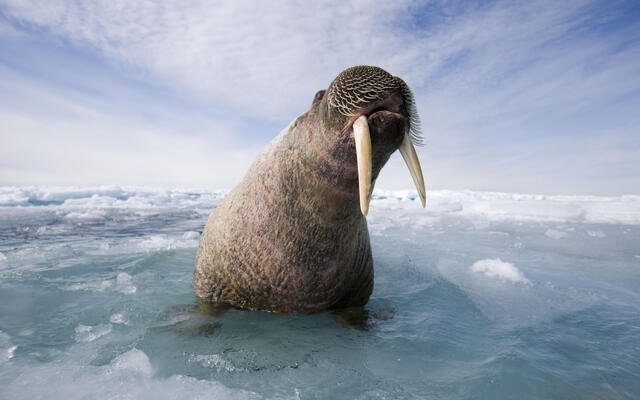
Imagine a tight-knit community of walruses huddled together on a sunlit iceberg. They’re social animals, often found in large groups, which makes their dwindling numbers all the more concerning. It’s a bit like watching your favorite team struggle to keep its star players on the field. Each walrus is crucial, not just for the group but for the health of the Arctic marine environment. So, are walruses really in trouble? Let’s break it down step by step.
Understanding the Walrus Population
Walruses, scientifically known as *Odobenus rosmarus*, are divided into two main species: the Atlantic walrus and the Pacific walrus. Both species are large, blubbery animals that can weigh up to 2,000 pounds and have distinct long tusks used for defense, dominance, and hauling themselves out of the water onto ice. The Atlantic walrus primarily resides in the northern waters of Canada and Greenland, while the Pacific walrus can be found in the Bering Sea and Chukchi Sea.
Unfortunately, walrus populations have been declining, primarily due to climate change. As the Earth warms, ice habitats are melting away, leaving these animals with fewer places to rest, breed, and give birth. Imagine living in a cozy neighborhood, and suddenly all the homes start disappearing. That’s essentially what’s happening to walruses as their ice platforms vanish.
Another significant threat to walruses is hunting and human activities. While regulated hunting does exist, illegal poaching can occur in certain areas, further threatening their numbers. Additionally, oil and gas exploration in their habitats disrupt feeding patterns and causes stress to the population. It’s a tough situation, and understanding these factors is crucial in the fight to protect walruses.
Why Are Walruses Important?
You might be asking yourself, “Why should I care about walruses?” Well, walruses are not just cute and cuddly; they play a key role in the Arctic ecosystem. They help maintain the health of marine ecosystems by feeding on benthic organisms—those little critters that live on the ocean floor. As walruses dive deep to forage for clams and other shellfish, they contribute to nutrient cycling in the ocean.
Plus, walruses are also an important part of the food chain. Polar bears, for instance, often prey on walrus calves, making them a vital resource for larger predators. If walrus populations continue to decline, it could set off a domino effect, impacting numerous other species and the overall health of the Arctic environment.
In simple terms, walruses are like the canary in a coal mine. Their well-being reflects the overall health of the Arctic ecosystem. If walruses are struggling, it’s a sign that the environment is facing serious challenges, and we should take notice.
Current Conservation Status
As of now, the IUCN (International Union for Conservation of Nature) lists walruses as vulnerable. This classification means they face a high risk of endangerment in the wild. The Pacific walrus, in particular, is under increased scrutiny due to climate change impacts, while the Atlantic walrus is also experiencing population pressures.
The U.S. Fish and Wildlife Service has implemented various conservation measures to help improve their status. These include habitat protection, monitoring populations, and reducing threats from climate change and human activities. It’s a multifaceted approach aiming to create a safer environment for these majestic creatures.
One significant effort is establishing protected areas where walruses can rest and breed without disturbances from ships or oil drilling operations. Think of these areas as safe havens—like a cozy retreat where walruses can relax without worry. These efforts are crucial in ensuring the survival of walrus populations for generations to come.
Climate Change and Its Impact
Honestly, climate change is the biggest elephant in the room when it comes to walrus conservation. With rising temperatures, Arctic ice is melting faster than we can blink. This loss of ice means walruses have fewer places to rest and must swim further to find food. It’s like being forced to go on a long road trip without a map—exhausting and stressful!
The effects of climate change extend beyond just ice loss. Warmer waters can alter the distribution of prey species, making it harder for walruses to find food. With their survival linked to the availability of food resources, these changes pose a significant threat to their populations.
Efforts to combat climate change, such as reducing greenhouse gas emissions and promoting sustainable practices, are vital. Every small action contributes to a larger goal of preserving not just walruses but their entire Arctic habitat.
Community Involvement and Education
Protecting walruses isn’t just up to scientists and government agencies; it’s a community effort. Local Indigenous communities play a crucial role in walrus conservation, often working in tandem with researchers to monitor populations and share traditional knowledge about their habitats. This collaboration helps inform better conservation strategies and ensures that the voices of those most affected by changes in walrus populations are heard.
Education is also a vital tool in this equation. By spreading awareness about the challenges walruses face, we encourage people to take action. This can range from supporting conservation organizations to making more sustainable choices in our daily lives. When communities understand the importance of walruses and their habitats, they’re more likely to rally for their protection.
Let’s face it—when we learn about issues, we’re more likely to care. Imagine holding a community event focused on walrus conservation, complete with fun activities and engaging discussions. These initiatives can spark interest and inspire people to get involved, making a real difference for walruses and the Arctic ecosystem as a whole.
What You Can Do to Help
So, what can you do to help walruses? Here are a few simple yet effective ways to make a difference:
- Support Conservation Organizations: Donate to or volunteer for groups working to protect walruses and their habitats.
- Spread the Word: Share information about walrus conservation on social media or in your community.
- Reduce Your Carbon Footprint: Make eco-friendly choices in your daily life by using public transport, reducing waste, or using energy-efficient appliances.
- Participate in Beach Clean-ups: Help keep marine environments clean and safe for all wildlife.
Every little bit helps! By taking these steps, you can contribute to the ongoing efforts to safeguard walruses and their delicate Arctic environment.
In conclusion, walruses are fascinating creatures facing serious threats due to climate change, habitat loss, and human activities. Understanding the challenges they face is essential in the collective effort to protect them. By staying informed and taking action, we can help ensure that these magnificent animals continue to thrive in their icy homes.
As we sip our coffee and look out at the world, let’s remember our role in preserving it for the future. Walruses may seem far away, but their well-being directly affects the entire Arctic ecosystem. Together, we can make a positive impact—not just for walruses, but for all the incredible life that depends on a healthy planet.

